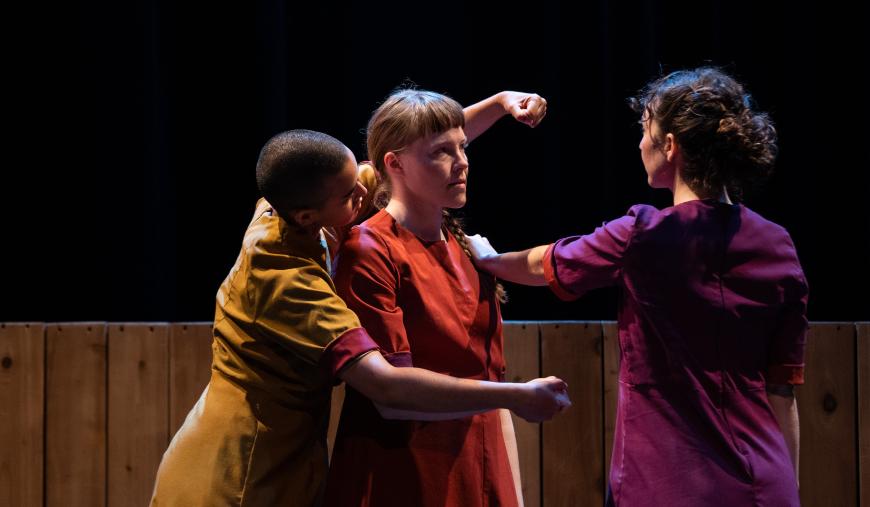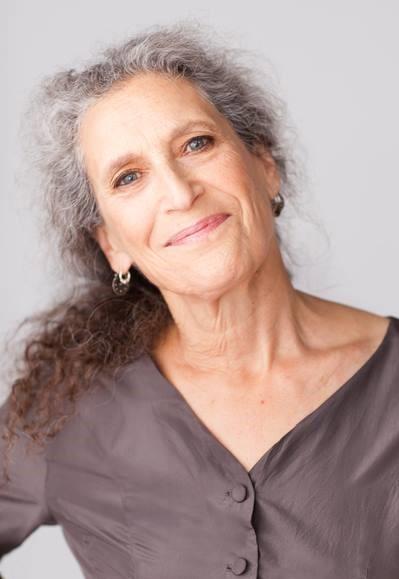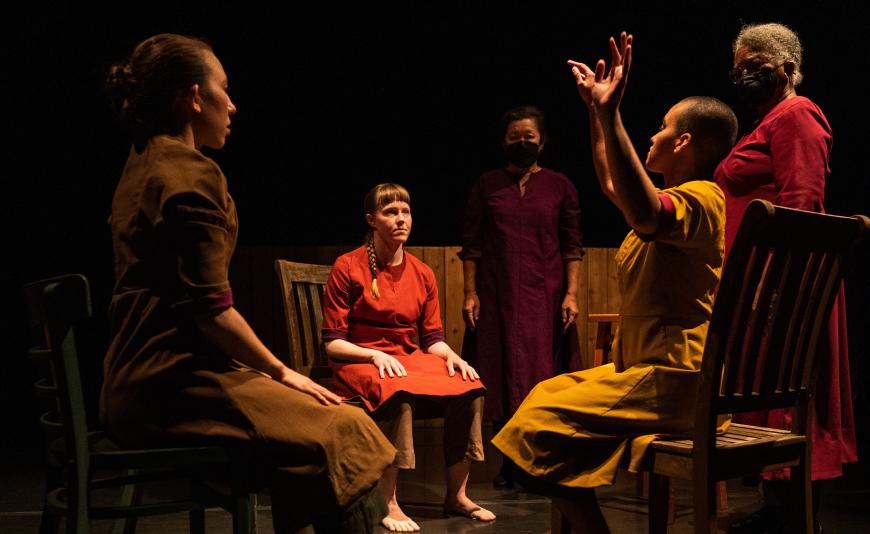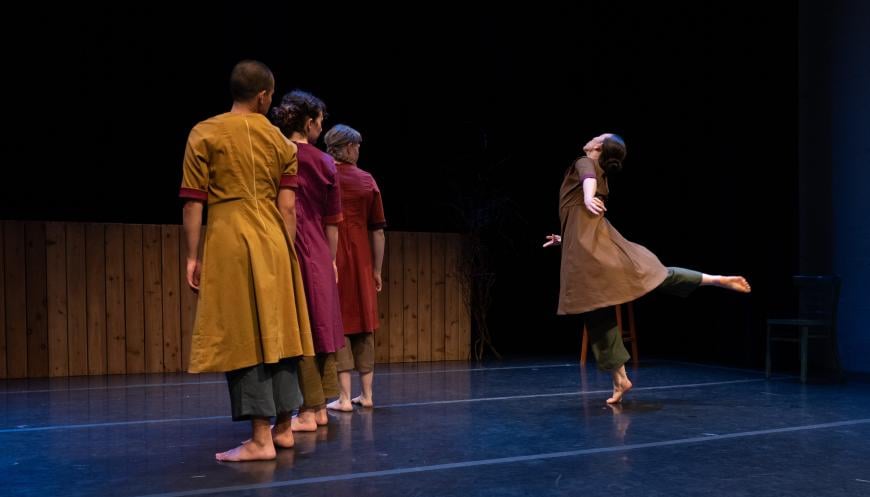
Even when she’s speaking, there’s choreography to Risa Jaroslow’s conversation. The dance maker was discussing the process of remounting Talking Circle, the evening-length work with a multigenerational cast that her company, Risa Jaroslow & Dancers (RJD), premiered at CounterPulse in May 2022 and reprises this January at Oakland Theater Project (OTP).
That an interview about a dance work can be described this way seems natural when Jaroslow, asked about the origins and structure of Talking Circle, says, “My idea at the beginning was that the whole piece would be a conversation. The impetus came from a story in a novel about a community, isolated, in which women were being badly treated. They had to make the choice to leave, which was very risky, or to stay. It raised the question of what is a freedom any one of us longs for. What would we risk to achieve that? Depending on who you are and your background, you have a different answer. That was a rich place to start the piece.”

The performers for Talking Circle include four RJD company dancers — Anna Greenberg, Phoenicia Pettyjohn, Cauveri Suresh, and Erin Yen — and two artists from The Elders Project — Pamela Wu Kochiyama and Sharon Dalke. That project was created in 2017 by Jaroslow and Sarah Crowell, artistic director of Oakland’s Destiny Arts Center, to bring young and old people together to engage in meaningful dialogue and to co-create new works.
The 60-minute, no-intermission production features music by Bay Area vocalist and composer Amy X Neuburg, lighting design by Allen Willner and Stephanie Anne Johnson, and costume design by Callie Floor. OTP is hosting the Risa Jaroslow company’s first-ever performances in Oakland with this production, which runs Jan. 6–15.
Jaroslow says the collaboration with OTP is a stimulating experiment for both parties. “I’ve never gone into a theater that has a history of only theater followers. They’ve never presented a dance company. We’re excited, and we all hope it works well. If it does, maybe other theaters will be interested in doing it. I’m also pleased to reach audiences that tend not to go over the bridge to see things in San Francisco.”
Talking Circle’s movement material was developed after the artists expressed individual opinions about risk and choice and engaged in a process Jaroslow calls “a negotiation.” The dance language they created consists of 42 gestures that form a basic vocabulary, and they manipulated and built upon the core elements in rehearsals.
The six dancers begin the work in a circle. “In a circle, people see each other,” Jaroslow says. “They can have differences, but they can still hold, hear, and be there for each other.”
Woven into that circle and every other structure and moment of the dance is the stunning, eclectic music composed by Neuburg. Jaroslow recalls a Q&A session held during the show’s run at CounterPulse and one dancer’s answer about how the music felt for a moving body. “She said it was like having a couture garment made just for you. That’s exactly right. Amy’s music creates an environment. It’s attentive to every movement and enhances every section.”

Neuburg often works with electronics, but for this piece, she and Jaroslow agreed that acoustic instruments and voices were needed. “She started with a cello. Then a moment came when I said a banjo would be great. So yeah, we got a banjo in there. The cello has that mellow, almost soothing sound; the banjo gives it a sense of a barn.”
Neuburg also recorded each performer speaking and incorporated bits of those voices into the score. The result is richly layered, evocative, and supportive, according to Jaroslow. “The flavors of the music are perfectly blended for what is happening in the movement. It’s something that’s ‘on you’ that feels perfect, just like that dancer said.”
Jaroslow has a long history of integrating diverse communities and people who are not formally trained as dancers into her works, be it in the cast or through conducting workshops with elder adults, gay and lesbian youth, women’s choirs, survivors of domestic abuse, people with disabilities, and others.
Asked specifically about the contributions of The Elder Project’s two featured dancers, Jaroslow says, “They have a special beauty that is informed by all the experiences of their lives. They are elegant, powerful, and we have a sense of them being protectors, guides perhaps, of the other dancers.”

Speaking more broadly about diverse casting, Jaroslow says there is a wonderful exchange when different kinds of movers inform and expand her dances. “Elders do more than they imagine they can, and younger dancers find the beauty and quietness of small movements. I work with people who are excited to be makers as well as performers. The magic, the best part of collaborating, is that my imagination is expanded when I see other people take material into places I would not have gone. The beauty is that stimulation to think in a new way. I am an instigator as well as a choreographer.”
Jaroslow says her approach to casting has picked up strength with the return of live performances following the COVID-19 lockdowns. “I think what has changed is that people like, more than ever before, to see people who are like them onstage. They like a mix of highly trained and not-trained dancers and find it inspiring. During nine years I worked in Poland. The last work was made for six American and four Polish dancers and a group of women who sang traditional choral music. There was a moment where four dancers lifted one woman in the chorus up while she was singing. The audience was thrilled. It was as if their babushka, their grandmother, was being lifted up. They were ecstatic. That idea of seeing yourself or people who could be in your life — to see that onstage with dancers is inspiring.”


